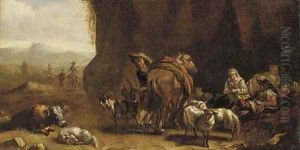Pieter Jacobsz Van Laer Paintings
Pieter Jacobsz van Laer was a Dutch Golden Age painter born in Haarlem, the Netherlands, in 1599. Often referred to as Pieter de Laer or by his nickname 'Il Bamboccio', which means 'The Puppet' or 'The Dwarf', due to his reportedly short stature, Van Laer specialized in genre scenes that depicted everyday life, as well as landscapes and animal scenes. His unique style greatly influenced the 'Bamboccianti', a group of mainly Dutch and Flemish artists working in Rome who were named after him and who adopted a similar style in their own works.
Van Laer moved to Italy at a young age, and it was in Rome that he developed his characteristic style. He stayed in Rome for a significant part of his career, roughly from 1625 to 1639, and his work was well received there. Van Laer's paintings often portrayed the lower classes of society and were known for their realism and attention to detail. His subjects included peasants, beggars, and street performers, often set in Roman or Italianate landscapes. His works were innovative for their candid portrayal of the less idealized aspects of life, which was a departure from the prevailing trends of the time that favored more heroic or romanticized depictions.
After his Italian sojourn, he returned to Haarlem, where he continued to paint and influence other artists. His Italianate landscapes and genre scenes had a significant impact on Dutch art, and his style can be seen in the works of many painters of the following generation. Van Laer's approach to genre painting helped pave the way for the later works of Dutch Realists, who also focused on scenes of everyday life.
Van Laer's death is recorded as occurring in 1642, although the exact circumstances and location of his death are not clear. Despite being relatively well-known in his own time, his work fell into obscurity in the centuries following his death. However, he has been rediscovered in more recent times, and art historians have come to recognize the importance of his contributions to the development of genre painting in the 17th century.
